Summary
- Personal contact with EAs was the most commonly selected influence on EAs’ ability to have a positive impact (40.9%), followed by 80,000 Hours (31.4%) and local EA groups (19.8%).
- Local EA groups were the most commonly cited source for making a new connection (35.5%), followed by a personal connection (34.1%), EA Global (26.2%), and EAGx (24.0%).
- Compared to 2020, relatively more respondents indicate having made an interesting and valuable new personal connection via EA Global and EAGx, and fewer via most other sources.
Introduction
In this post, we report on what factors EAs say helped them have a positive impact or create new connections. Note that we significantly shortened the EA Survey this year, meaning there are fewer community-related questions than in the previous EA Survey.
Positive Influences
We asked about which factors, within the last 12 months, had the largest influence on your personal ability to have a positive impact, allowing respondents to select up to three options. On average, respondents selected 2.36 options (median 3).
Personal contact with EAs stood out as the most common factor selected by respondents (40.9%), followed by 80,000 Hours (combined[1], 31.4%), and local EA groups (19.8%).
Personal contact, 80,000 Hours, and EA groups were also the top three factors that respondents reported as being important for getting them involved in EA.
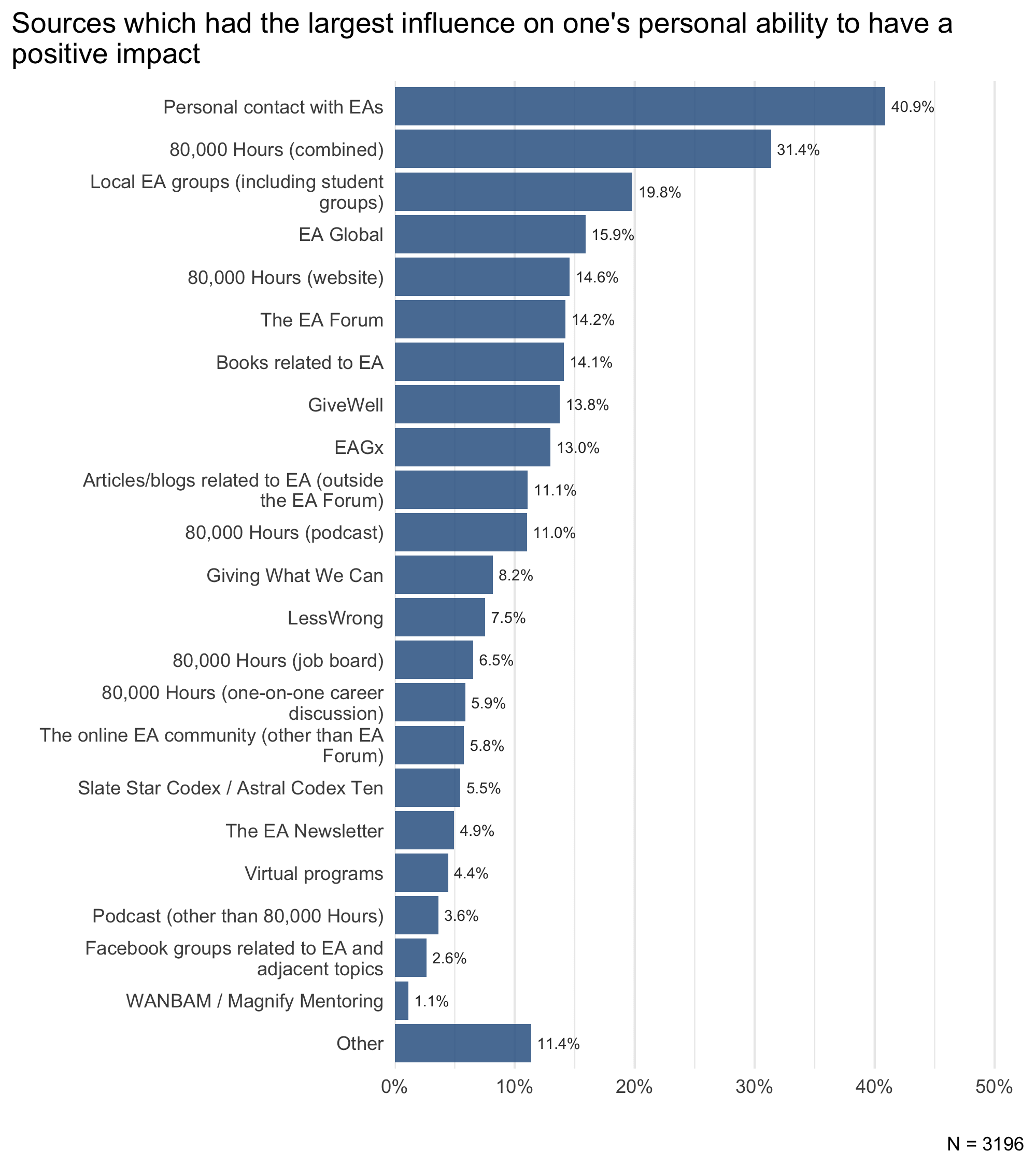
2020 vs. 2022
We asked a similar question in 2020, though this year we specifically asked about impacts within the last 12 months, whereas last year the question was not time-limited. This likely accounts for the significant drops in some categories observed below (particularly affecting those factors which had a large influence more than 12 months ago).
In addition, we changed some of the response categories. This year we included 80,000 Hours (job board), the online EA community (other than EA Forum), and Virtual programs, but dropped Animal Charity Evaluators, The Life You Can Save, and Animal Advocacy Careers. These categories were dropped due to low endorsement rates in previous years.
Compared to 2020, we see an increase in EA Global, the EA Forum, EAGx, and 80,000 Hours one-on-one career discussion as important sources for greater impact. These increases were quite small in most cases, with the biggest change observed for EAGx (from 6% to 13%). We saw multiple decreases, some quite sizable, in local EA groups, 80,000 Hours (both the website and podcast), Books, GiveWell, Articles/blogs, Giving What We Can, LessWrong, Slate Star Codex/Astral Codex Ten, podcasts, and Facebook groups.
A portion of the decrease of the website of 80,000 Hours can be attributed to the addition of the 80,000 Hours job board category in this year’s survey. Last year, respondents may have included this category in the website category of 80,000 Hours, while this year it was its own category. Including the job board category with the website category leads to a smaller decrease between 2022 and 2020, although it does not fully account for it.[2]
It’s important to recall that these questions asked about which factors had had the largest influence within the last 12 months. Thus, the percentages of respondents who have been influenced by these factors at some point are likely larger than those reporting having been influenced in the last 12 months within this survey. Responses to this question might also be expected to change more, across years, than our questions which are not limited to the last 12 months.
Gender
Respondents who indicated identifying as a man were more likely to select the EA Forum, GiveWell, the 80,000 Hours podcast and one-on-one career discussion, LessWrong, and Slate Star Codex/Astral Codex Ten as having the largest influence. Respondents who did not indicate identifying as a man were more likely to select local EA groups, WANBAM/Magnify Mentoring, and Other sources.
Racial identity
We observed a few differences between respondents identifying as white compared to respondents not identifying as white. White respondents were more likely to select GiveWell and the 80,000 Hours podcast, while non-white respondents were more likely to select the 80,000 Hours website and virtual programs.
Engagement
We also looked at differences between respondents with low vs. high engagement, although it should be noted that the engagement options that respondents could select included specific references to sources that were also in the list of potential positive influence sources.[3]
With this in mind, we found that high engagement respondents were more likely to select personal contact with EAs, local EA groups, EA Global, the EA Forum, EAGx, the online EA community, 80,000 Hours one-on-one career discussion, virtual programs, WANBAM/Magnify monitoring, and Other sources.
Less engaged respondents were more likely to select the 80,000 Hours website and job board, GiveWell, books, articles, and blogs related to EA, the 80,000 Hours podcast, Giving What We Can, Slate Star Codex/Astral Codex Ten, the EA newsletter, and podcasts.
New Connections
We also asked respondents about which sources, if any, resulted in an interesting and valuable new personal connection[4] in the last year. There was no limit on the number of sources they could select. On average, respondents selected 2.23 options (median 2; excluding ‘None of these options’).
Local EA groups were the most commonly cited source for making a new connection (35.5%), followed by a personal connection (34.1%), EA Global (26.2%), and EAGx (24.0%). A sizable portion of respondents indicated that none of the provided options (‘None of these options’) were a source (19.0%) or that there was another source (‘Other’, 13.9%).
2020 vs. 2022
Comparing this year’s results to 2020, we find that relatively more respondents indicate having made an interesting and valuable new personal connection via EA Global and EAGx, and fewer via most other sources, including Facebook groups, EA books, LessWrong, international EA social events, Giving What We Can, the EA newsletter, EA Student Career Mentoring/Global Challenges Project, Effective Thesis, and the EA Hub.
Gender
We generally did not observe many gender differences in sources for new connections, although we did find that respondents identifying as a man were more likely to select the EA Forum and LessWrong as a source, and less likely to select EA Student Career Mentoring/Global Challenges Project.
Racial identity
We observed several small differences between respondents identifying as white compared to respondents not identifying as white. White respondents were more likely to select the ‘None of these options’ category, while relatively more non-white respondents selected non-local meetups, EA Student Career Mentoring/Global Challenges Project, and the EA Hub.
Engagement
Highly engaged respondents were more likely to indicate making a new connection via EA Global, EAGx, a personal connection, local EA groups, Other sources, the EA Forum, international events, non-local groups, Giving What We Can, the EA Hub, and Effective Thesis. Less engaged respondents were more likely to select the EA Newsletter and None of these options.
Appendix
We also performed an additional analysis looking at differences between respondents classified as prioritizing neartermist causes or longtermist causes. This categorization was based on a cluster analysis of the responses to each cause prioritization question. The cluster analysis revealed three clusters, which could be interpreted as a neartermist cluster, a longtermist cluster, and one indicating high agreement with almost all cause areas (not shown below).
Regarding factors that had the largest influence on one’s personal ability to have a positive impact, we found that the differences were similar to the differences we observed between low and highly engaged respondents (which is to be expected, since highly engaged respondents are disproportionately longtermist). Longtermist respondents were more likely to select personal contact with EAs, EA Global, the EA Forum, LessWrong, local EA groups, EAGx, 80,000 Hours (podcast and one-on-one career discussion), and the online EA community than neartermist respondents. Neartermist respondents, on the other hand, were more likely to select GiveWell, Giving What We Can, articles/blogs related to EA, the EA Newsletter, 80,000 Hours job board, and podcasts.
Below are the differences between neartermist and longtermist respondents regarding sources of making an interesting and valuable new personal connection. These differences also largely mimic the ones observed between low and highly engaged respondents. Longtermist respondents were more likely to select EA Global, a personal connection, EAGx, local EA groups, LessWrong, Other sources, the EA Forum, and international events. Neartermist respondents were more likely to select None of the options, EA books, and the EA Newsletter.
This research is a project of Rethink Priorities. This post was written by Willem Sleegers and David Moss. We would also like to thank Peter Wildeford, Jamie Elsey, Adam Papineau, and Ben Snodin for comments.
If you like our work, please consider subscribing to our newsletter. You can see more of our work here.
- ^
We combined the 80,000 Hours categories together to form a single 80,000 Hours (combined) category in order to assess the overall influence of 80,000 Hours and to better compare these results to other questions from the EA survey (e.g., where respondents first heard of EA).
- ^
As in previous analyses , we also examined the effect of being referred to the survey from 80,000 Hours on selecting options related to 80,000 Hours. Fully excluding all respondents who were referred from 80,000 Hours (which, as we argued before, would likely represent a dramatic over-correction) only reduced the proportion selecting the 80,000 Hours website from 14.6% to 10.4%, and 80,000 Hours podcast from 11.0% to 9.28%.
- ^
There were five options respondents could select to indicate their engagement with EA (see below). Respondents who selected either ‘Considerable engagement’ or ‘High engagement’ were classified as ‘High engagement’ in our binary classification, while respondents who selected any of the lower engagement categories were classified as ‘Low engagement.’
No engagement: I’ve heard of effective altruism, but do not engage with effective altruism content or ideas at all.
Mild engagement: I’ve engaged with a few articles, videos, podcasts, discussions, and/or events on effective altruism (e.g., reading Doing Good Better or spending ~5 hours on the website of 80,000 Hours).
Moderate engagement: I’ve engaged with multiple articles, videos, podcasts, discussions, and/or events on effective altruism (e.g., subscribing to the 80,000 Hours podcast or attending regular events at a local group). I sometimes consider the principles of effective altruism when I make decisions about my career or charitable donations.
Considerable engagement: I’ve engaged extensively with effective altruism content (e.g., attending an EA Global conference, applying for career coaching, or organizing an EA meetup). I often consider the principles of effective altruism when I make decisions about my career or charitable donations.
High engagement: I am heavily involved in the effective altruism community, perhaps helping to lead an EA group full time or working at an EA-aligned organization. I make heavy use of the principles of effective altruism when I make decisions about my career or charitable donations.
- ^
The list of possible sources also included ‘a personal connection’ for respondents to indicate that they made a new connection via an existing personal connection.

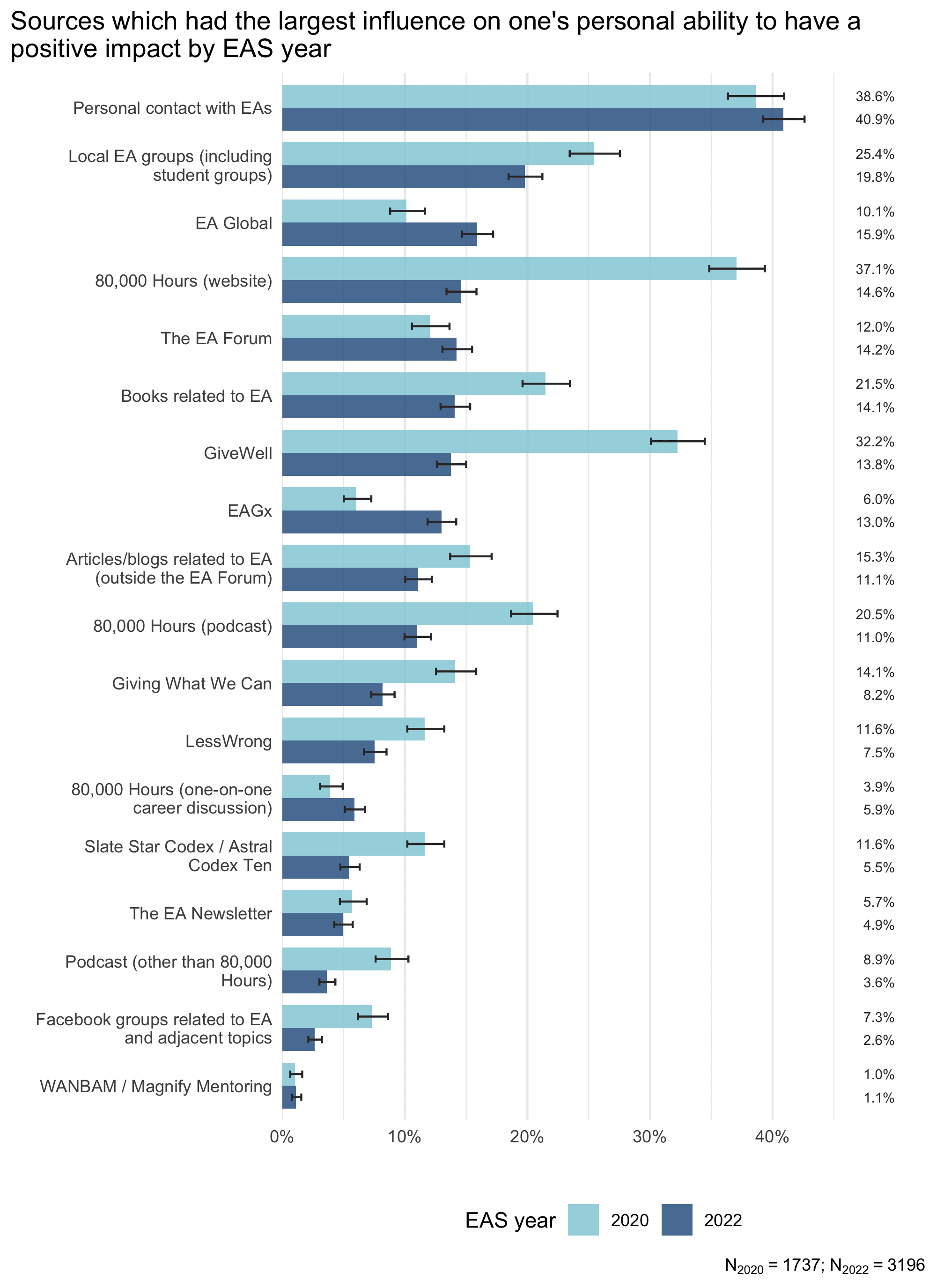
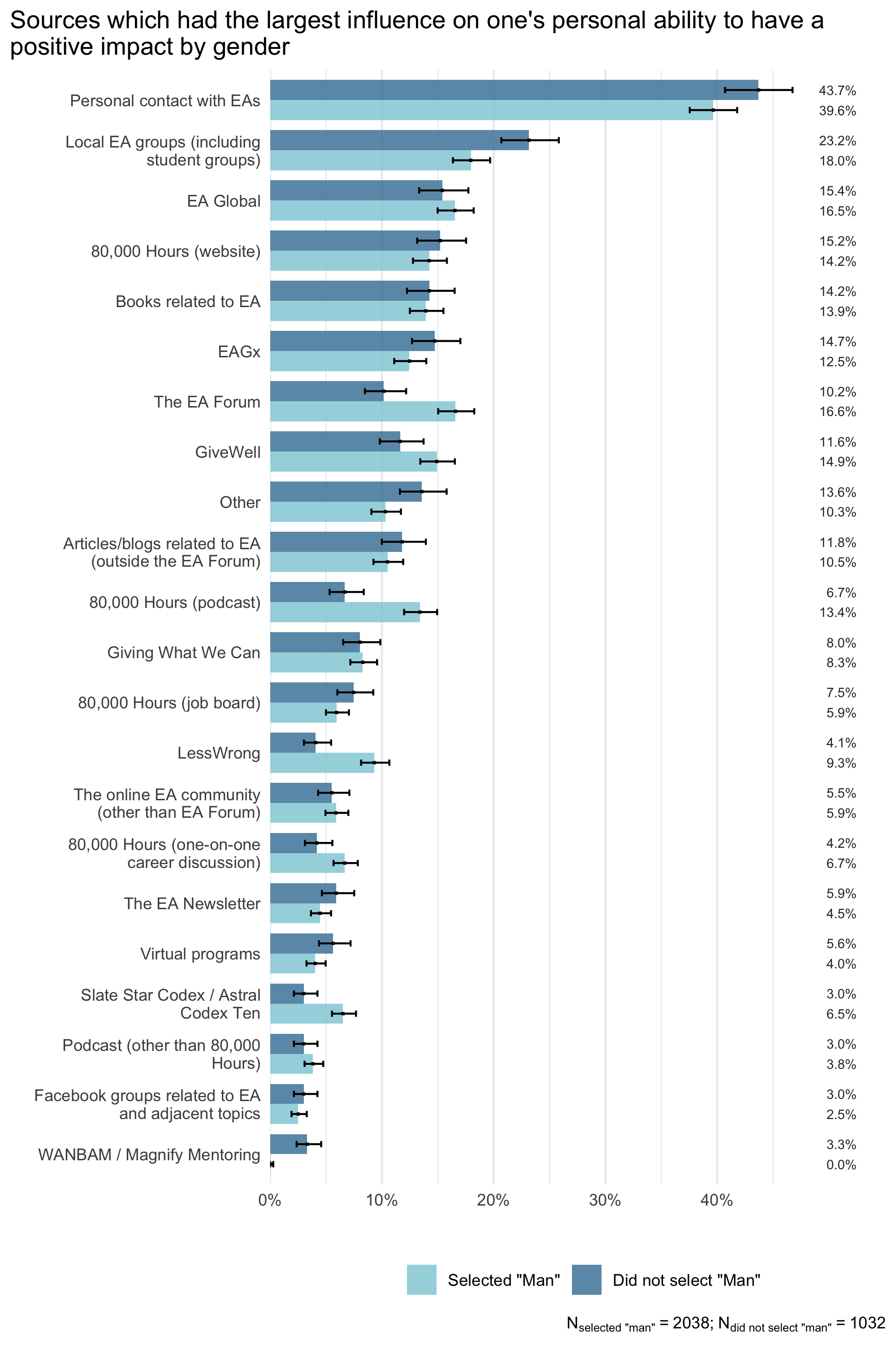
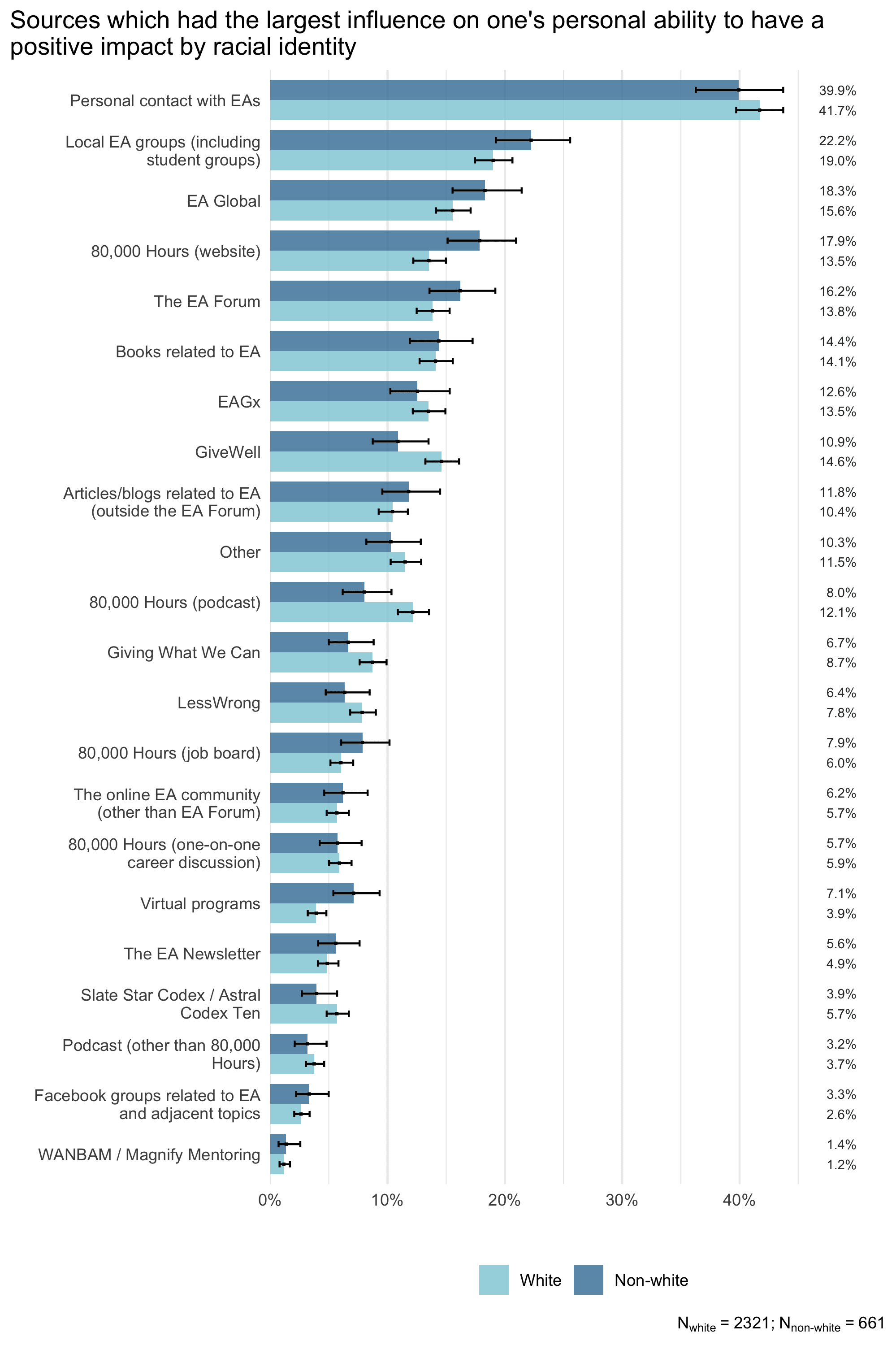
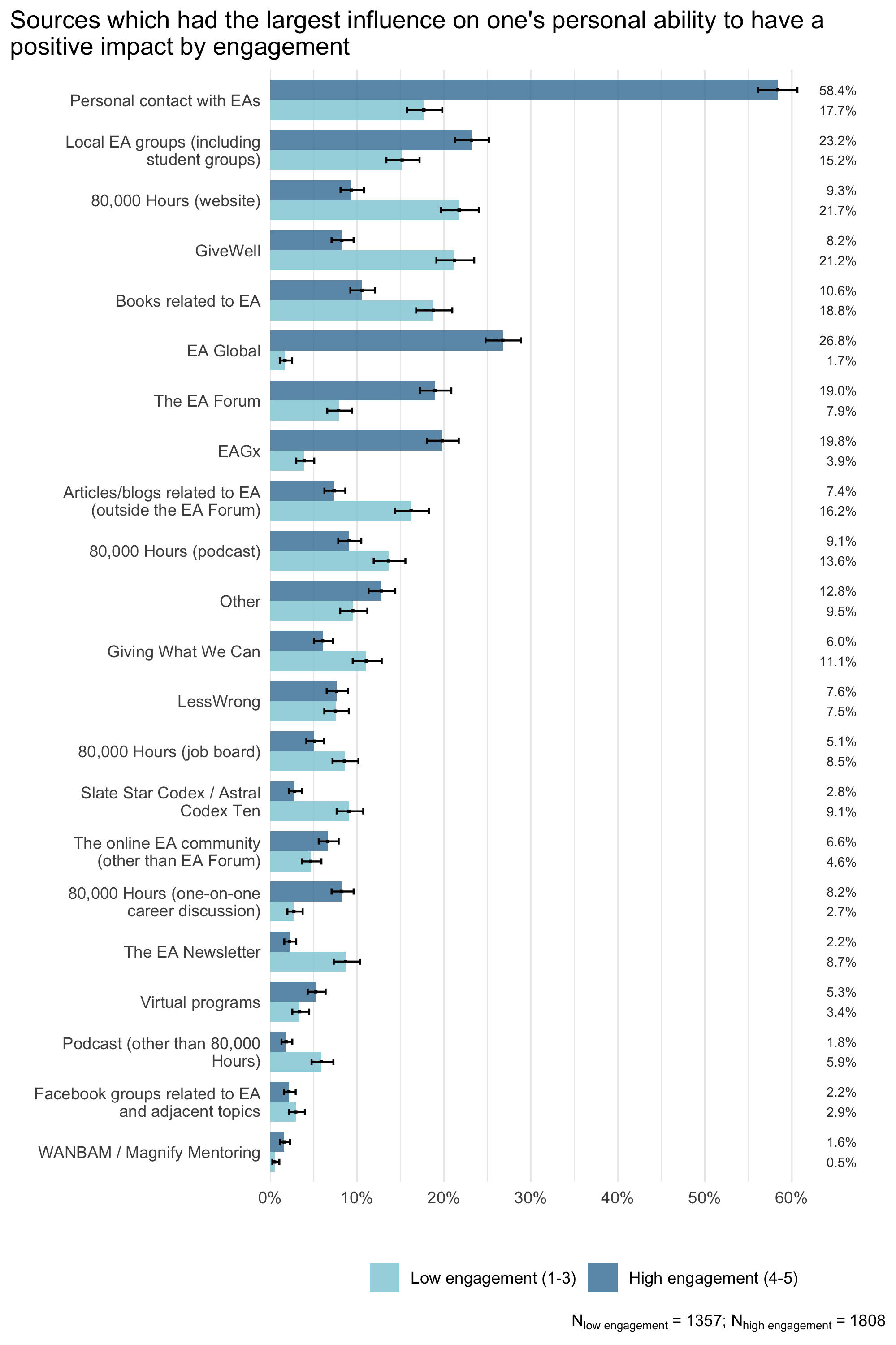

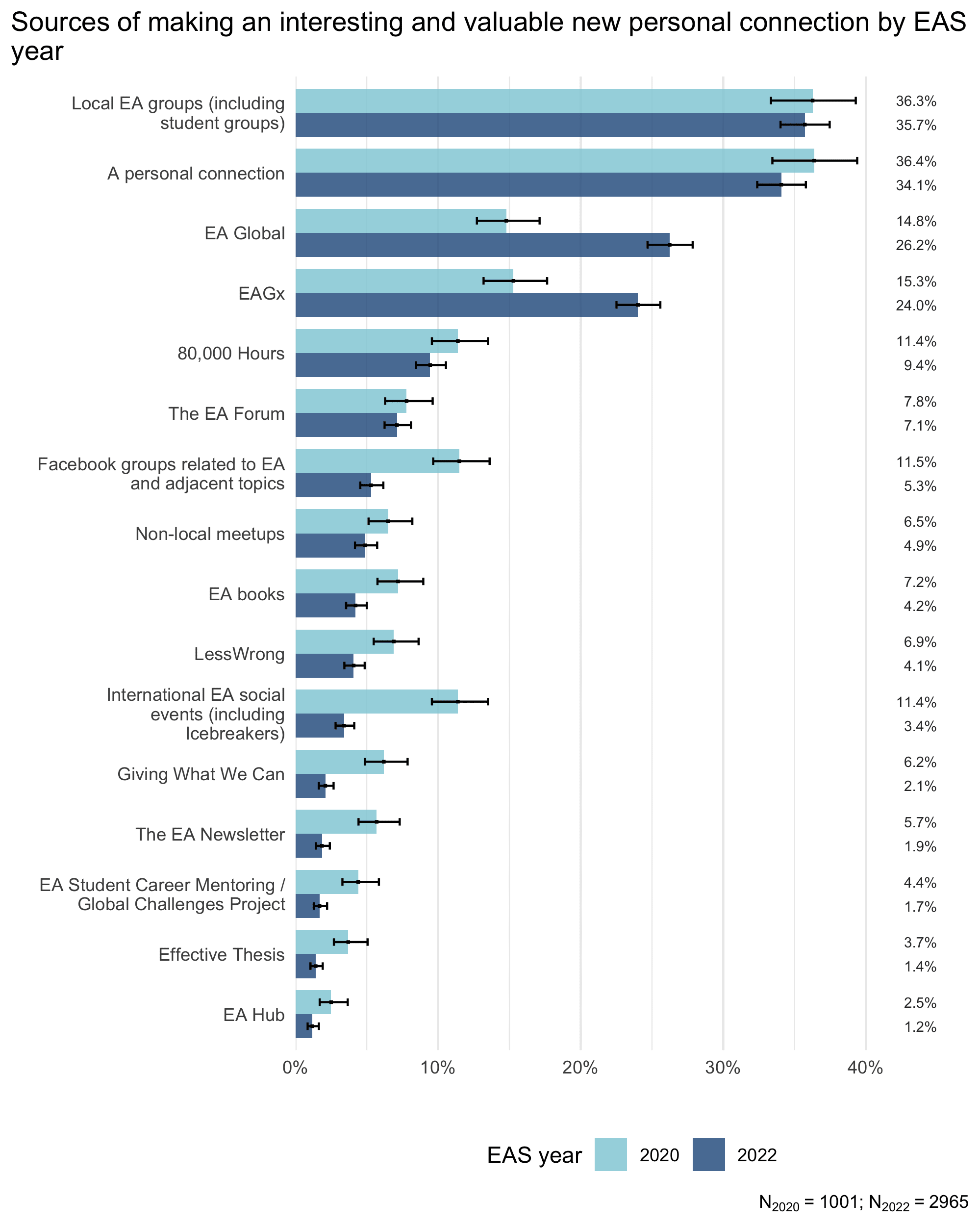

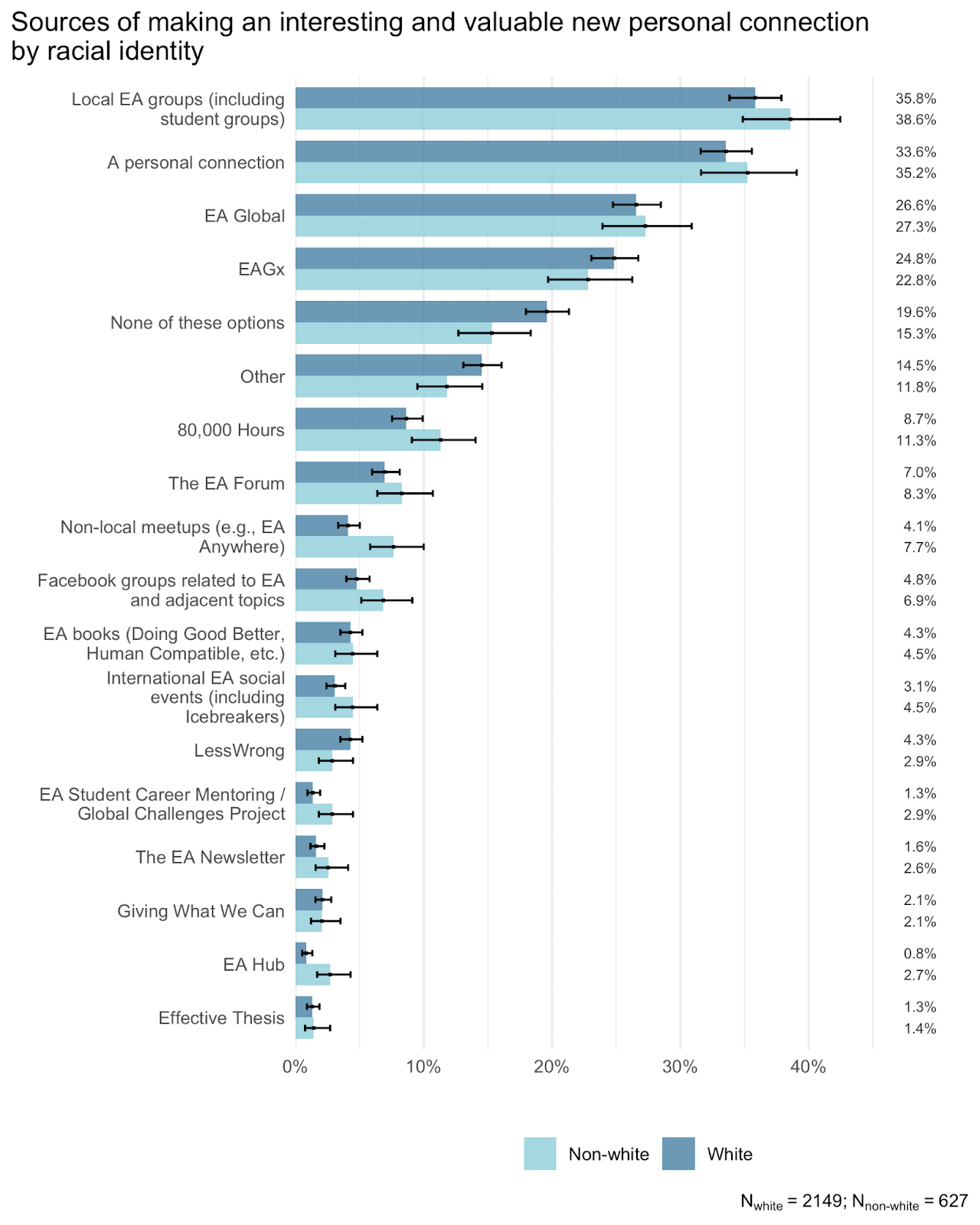
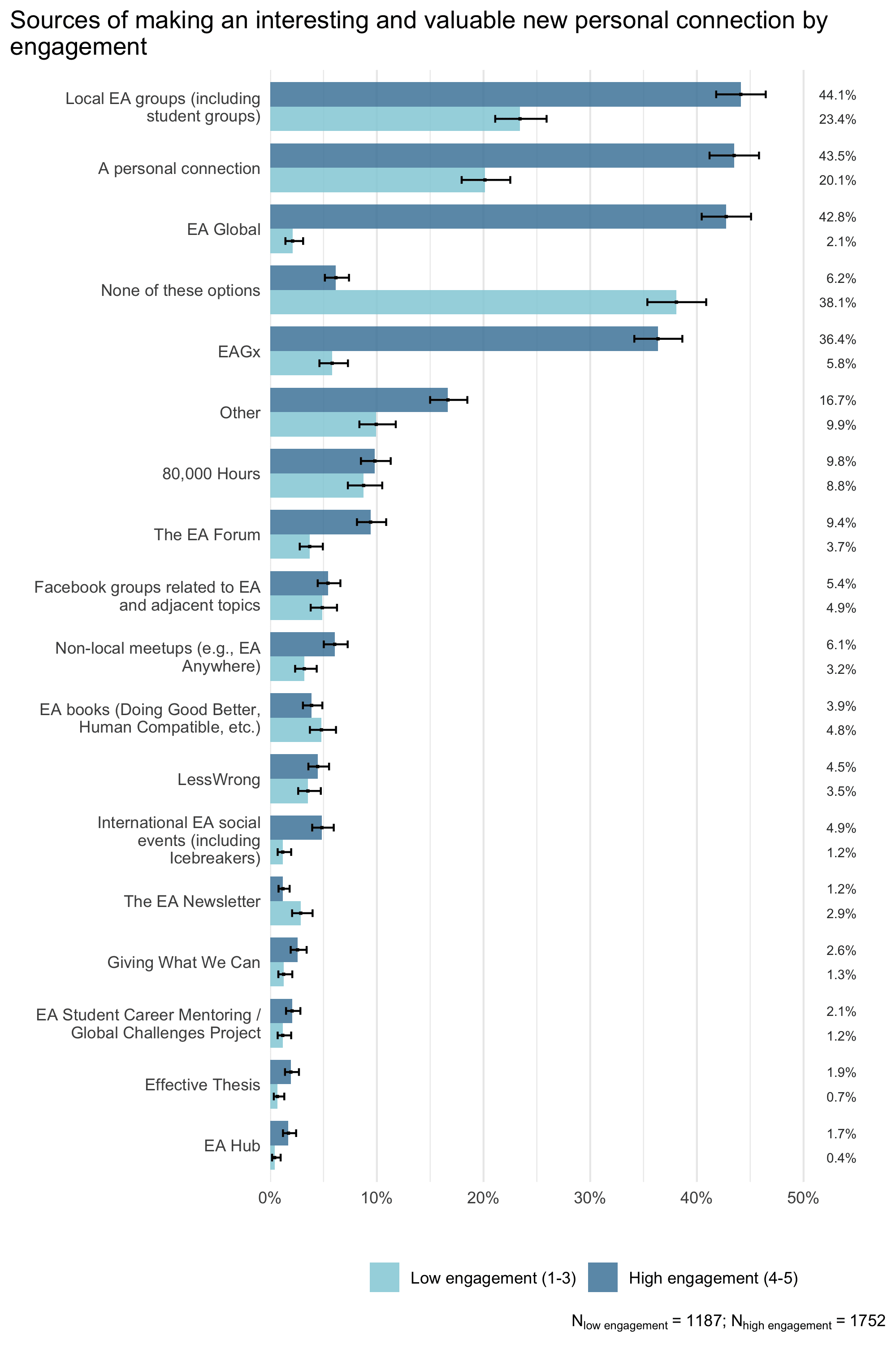
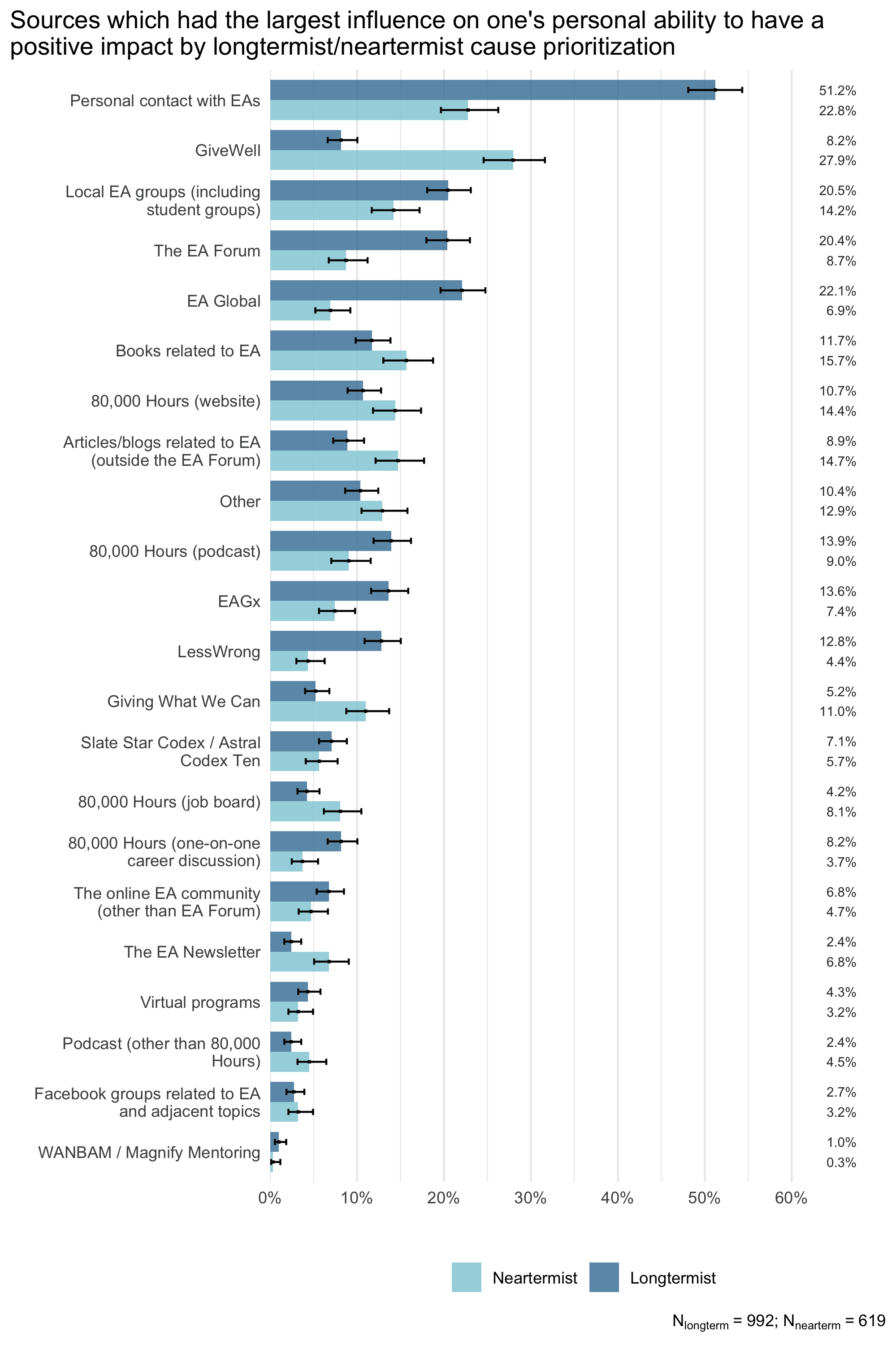
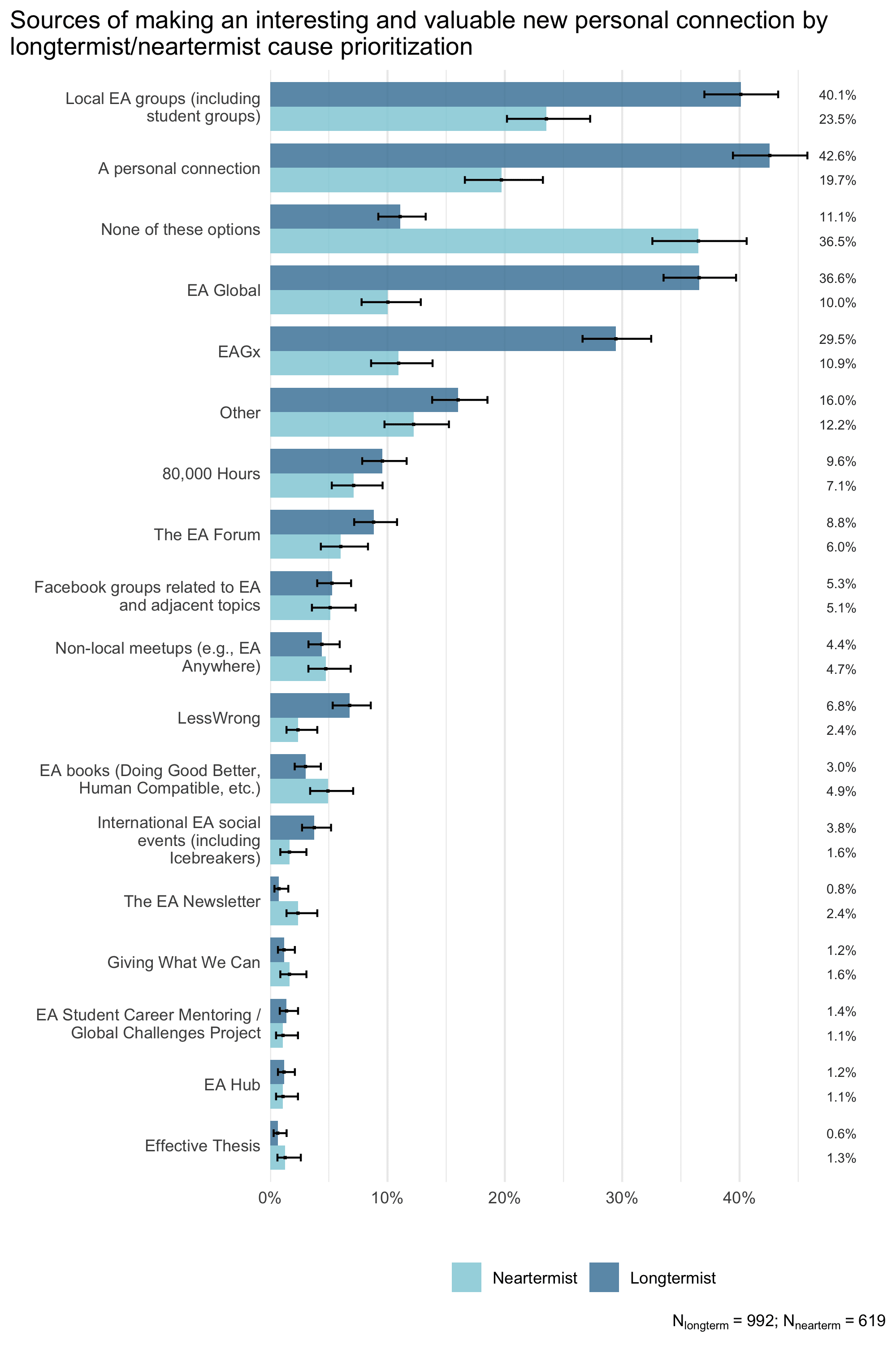

Thanks for this! Is there much variation between countries/categories of countries? For example, it'd be great to see how the Netherlands varies compared to other places, or whether there's a difference between anglosphere and non-anglosphere.
Thanks for the question James.
There are some differences between regions (USA, UK, Other Europe, Rest of the world), as you can see in the graphs below.
Since you also specifically mentioned the Netherlands, I also looked at the differences between the Netherlands and all other countries. There were only a total of 108 respondents from the Netherlands, so the confidence intervals are pretty wide, but some of the differences seem large enough to be potentially interesting.
Feel free to ask any questions you might have about these results!
Amazing, thanks Willem!
I love the consistency and quality of these surveys :)
A couple of questions regarding the "positive influence" survey:
Thanks for the comment!
Thanks, that makes sense :)